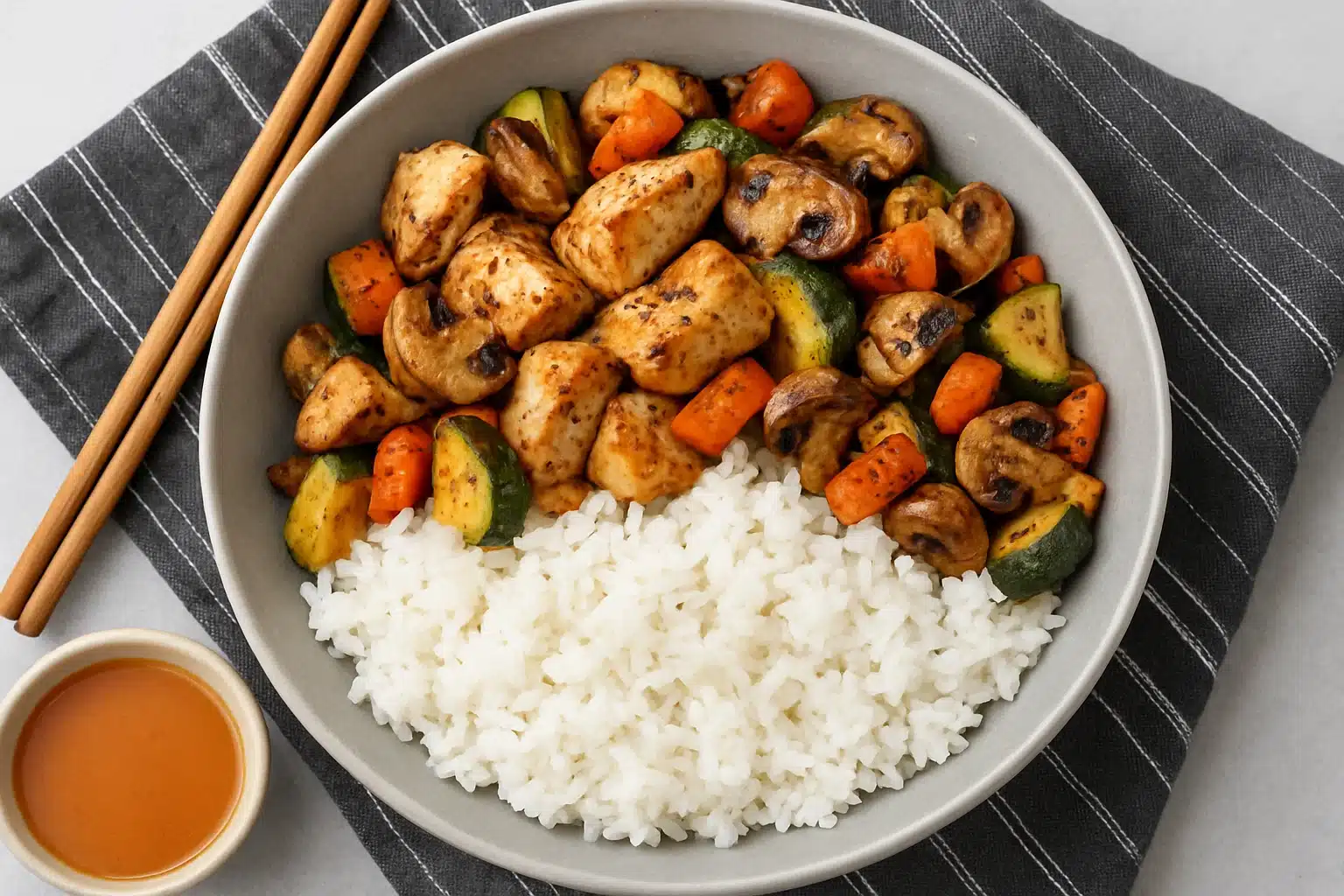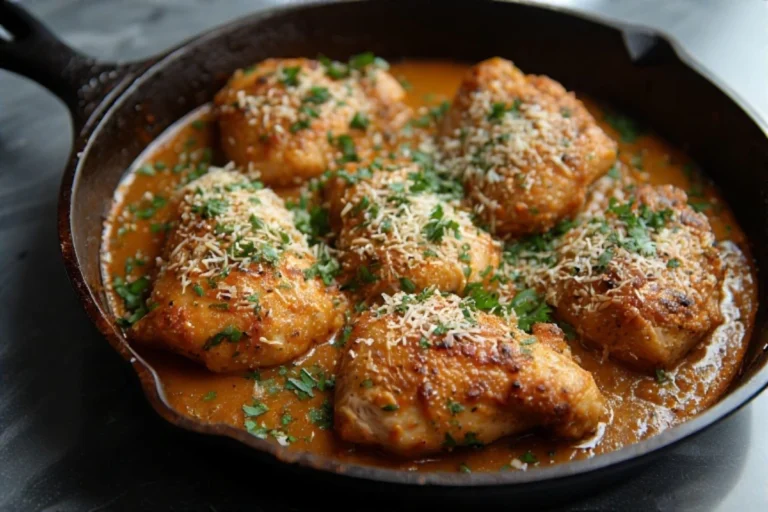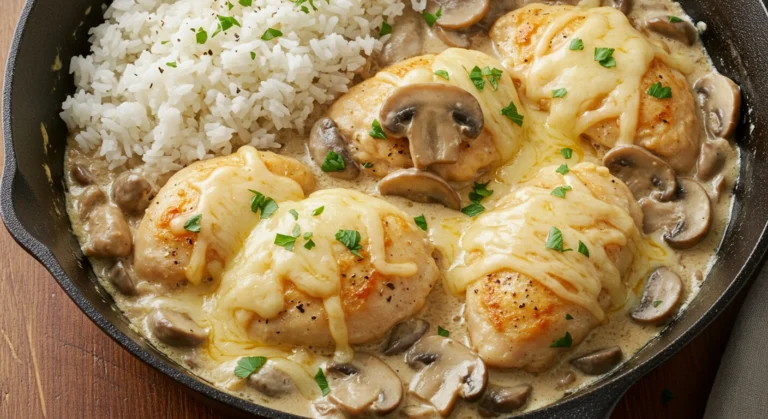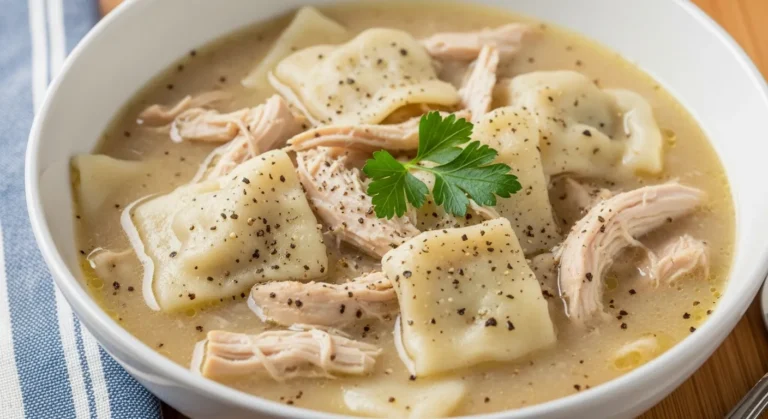Hibachi Chicken: The Best Homemade Recipe for Authentic Flavor
Hibachi chicken is one of the most flavorful and satisfying dishes you can make at home. Known for its rich, buttery flavor, tender chicken, and crisp vegetables, this Japanese steakhouse favorite is no longer just reserved for restaurant outings. With the right ingredients and a few simple techniques, you can make hibachi chicken in your own kitchen that rivals anything from your favorite teppanyaki grill.
If you’ve ever sat at a sizzling grill watching a chef expertly toss shrimp into hats and slice chicken at lightning speed, then you know just how fun and delicious chicken hibachi can be. This guide will walk you through everything—how to prepare it, what ingredients to use, secret sauces, and chef-approved tips to get that authentic taste at home.
What is Hibachi Chicken? A Flavor-Packed Japanese Grilled Dish
Understanding the Origins and Meaning of Hibachi
The word hibachi comes from Japan and originally referred to a “fire bowl”—a traditional heating device. However, in modern American cuisine, hibachi has evolved into a style of cooking where food is prepared over a high-heat flat-top grill, usually right in front of the diner.
Hibachi chicken, specifically, is a grilled chicken dish typically served with stir-fried vegetables, rice, and a side of yum yum sauce. The focus is on fast, high-heat cooking that locks in moisture while developing a deep, savory, caramelized flavor from ingredients like soy sauce, sesame oil, and garlic.
Unlike slow-cooked barbecue or marinated stir-fries, hibachi chicken is cooked quickly and seasoned just before or during cooking. That means minimal prep, maximum taste.
PrintHibachi Chicken with Veggies & Yum Yum Sauce
This easy hibachi chicken recipe brings the Japanese steakhouse experience to your kitchen—complete with tender chicken, stir-fried veggies, and a creamy homemade yum yum sauce. Quick, flavorful, and perfect for busy weeknights or meal prep!
- Prep Time: 15 min
- Cook Time: 15 min
- Total Time: 30 minutes
- Yield: 4 1x
- Category: Main Course
- Cuisine: Japanese
Ingredients
2 teaspoons sesame oil, divided
2 teaspoons vegetable or olive oil, divided
2 tablespoons butter, divided
3 boneless skinless chicken breasts, cubed
3 tablespoons low-sodium soy sauce, divided
3 cloves garlic, minced
Salt and pepper, to taste
2 zucchini, chopped
1 onion, chopped
1 carrot, sliced
1 package (8 oz) cremini mushrooms, halved
2 cups cooked white or fried rice
Yum Yum Sauce:
1 cup mayonnaise
1 tablespoon ketchup
1 tablespoon rice vinegar
¾ teaspoon paprika
⅛ teaspoon garlic powder
Salt and pepper, to taste
Instructions
Heat 1 tsp sesame oil + 1 tsp vegetable oil over medium-high heat. Add chicken, season, and sauté 1 min.
Stir in 1 tbsp butter, 1 tbsp soy sauce, and garlic. Cook until chicken is done. Set aside.
In same pan, add remaining oils. Sauté veggies 2–3 minutes.
Add 1 tbsp butter + 1 tbsp soy sauce + salt & pepper. Stir-fry until tender. Return chicken to pan.
Serve over rice. Mix yum yum sauce ingredients and chill for 1 hour before serving.
Nutrition
- Serving Size: 4
- Calories: 364kcal
- Sugar: 7g
- Sodium: 1092mg
- Fat: 25g
- Saturated Fat: 7g
- Unsaturated Fat: 16g
- Trans Fat: 0.3g
- Carbohydrates: 14g
- Fiber: 2g
- Protein: 21g
- Cholesterol: 78mg
Keywords: Hibachi Chicken, Teriyaki, soy sauce, skinless chicken breasts, sesame oil, Hoisin sauce, zucchini, white rice, Fried rice, skinless chicken breast, yum yum sauce
What Makes Hibachi Chicken Unique Compared to Teriyaki Chicken
Many people confuse teriyaki chicken with hibachi chicken—but the two are surprisingly different.
| Feature | Hibachi Chicken | Teriyaki Chicken |
|---|---|---|
| Sauce Base | Soy sauce, garlic, butter, sesame oil | Teriyaki glaze (soy sauce, mirin, sugar) |
| Cooking Method | High-heat grilling on flat top | Often grilled or pan-fried with glaze |
| Flavor Profile | Savory, smoky, buttery | Sweet, sticky, and slightly tangy |
| Veggie Pairing | Zucchini, carrots, mushrooms, onions | Often served with steamed broccoli or rice |
| Common Sauces | Yum yum sauce, soy butter | Teriyaki sauce only |
Whereas teriyaki chicken is all about that thick, sugary glaze, chicken hibachi lets the natural richness of the chicken shine with a buttery, umami-forward seasoning profile. It’s lighter, saltier, and often paired with fried rice and hibachi vegetables.
If you’re looking for a more savory, grilled experience, hibachi chicken is the way to go. It’s also incredibly easy to make with a few ingredients and no fancy tools.
Key Ingredients for Hibachi Chicken You Can Find in Any Kitchen
You don’t need fancy sauces or hard-to-pronounce spices to make hibachi chicken at home. With just a handful of pantry staples and a few fresh vegetables, you’ll be well on your way to creating a restaurant-quality meal in under 30 minutes.
Let’s break down the essential ingredients that make this hibachi chicken recipe shine.
Essential Proteins: Chicken Breasts, Thighs, or Shrimp
The heart of any chicken hibachi recipe is, of course, the chicken. Most Japanese steakhouses use boneless skinless chicken breasts, cut into small bite-sized cubes so they cook fast and evenly on a hot grill. However, if you prefer more tenderness and a richer taste, skinless chicken thighs are a fantastic alternative.
Want to mix it up? You can also substitute the chicken with steak or shrimp, just like they do at hibachi restaurants. A combination of shrimp and chicken, also called “duo hibachi,” is a popular menu item in places like Kobe Express Hibachi Chicken and Fish in Warner Robins.
Pro Tip: Cut your chicken into uniform 1-inch cubes to ensure even cooking and a perfect sear.
Flavor Boosters: Soy Sauce, Sesame Oil, Garlic, and Butter
What gives hibachi chicken that savory, slightly sweet, smoky flavor? The answer lies in a few powerful ingredients:
- Low-sodium soy sauce – Adds depth without overpowering saltiness.
- Sesame oil – Offers nutty aroma and a hint of smokiness.
- Minced garlic – For that irresistible bite and bold flavor.
- Butter – Yes, butter. Hibachi chefs often rely on a hearty scoop of butter to boost flavor and seal in the chicken’s natural juiciness.
Some chefs even use a splash of olive oil or vegetable oil at the start to prevent sticking and help with even searing. A small drizzle—about a teaspoon—of each oil is all you need to bring out rich, savory depth without overpowering the dish.
Colorful Veggies: Zucchini, Mushrooms, Onions, and Carrots
Hibachi meals are never just about the protein. The vibrant vegetables are just as essential.
This recipe uses:
- 2 zucchini, chopped
- 1 medium onion, chopped
- 1 carrot, thinly sliced
- 1 package of fresh cremini mushrooms, halved
These veggies cook quickly over high heat, soaking up the soy sauce and butter to create that signature hibachi stir-fry flavor. If you’d like, you can also add red bell peppers, yellow squash, or even baby carrots.
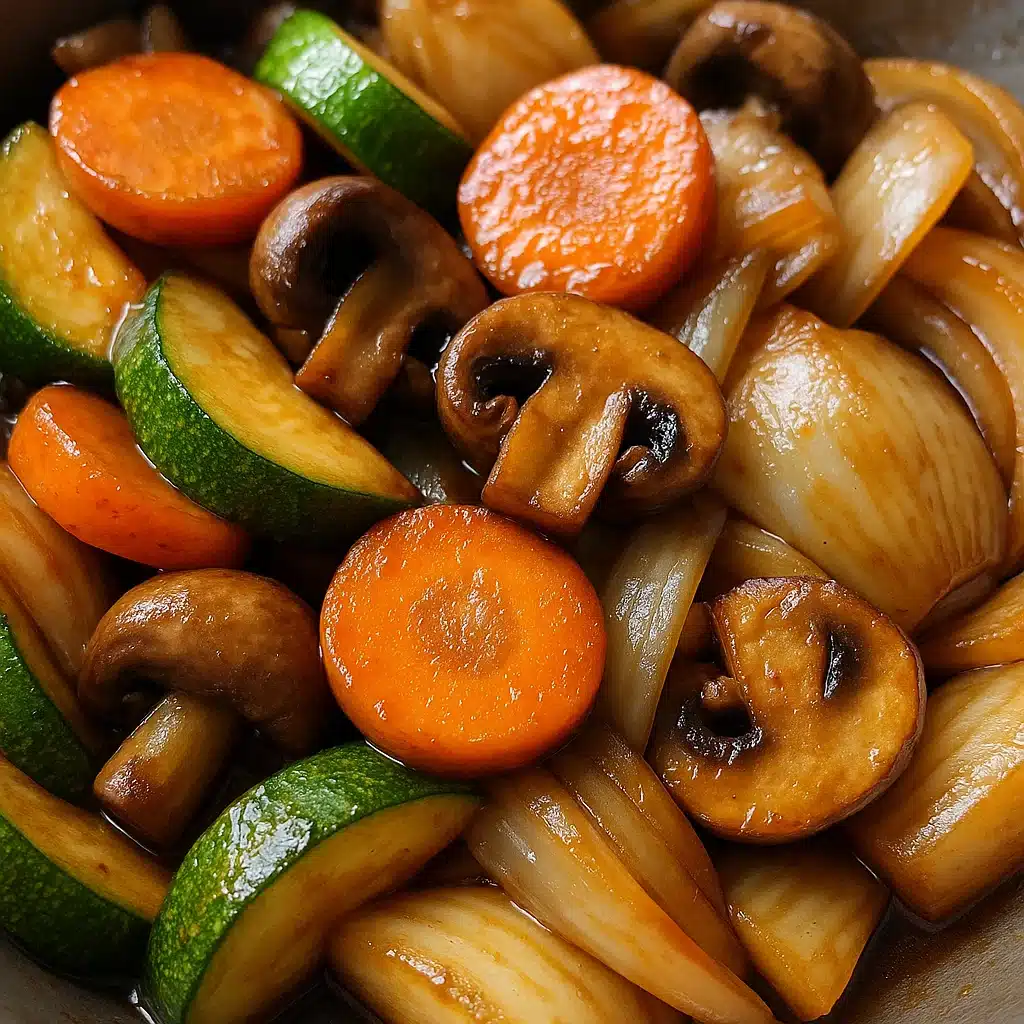
The Base: White Rice or Fried Rice
No hibachi dish is complete without rice. Serve your hibachi chicken over:
- Steamed white rice for a simple, clean base
- Or go bold with hibachi chicken fried rice, stir-fried with garlic, eggs, and soy sauce
Either way, the rice balances the intense flavors of the chicken and veggies. Feel free to use leftover rice for a quick weeknight meal.
The Best Hibachi Chicken Marinade and Sauce Guide
Creating that bold, restaurant-style flavor at home starts with a killer sauce—and a few smart seasoning tips. Whether you’re wondering if you should marinate your chicken or just looking for the perfect dip, this section breaks down all the essentials for flavor-packed hibachi chicken.
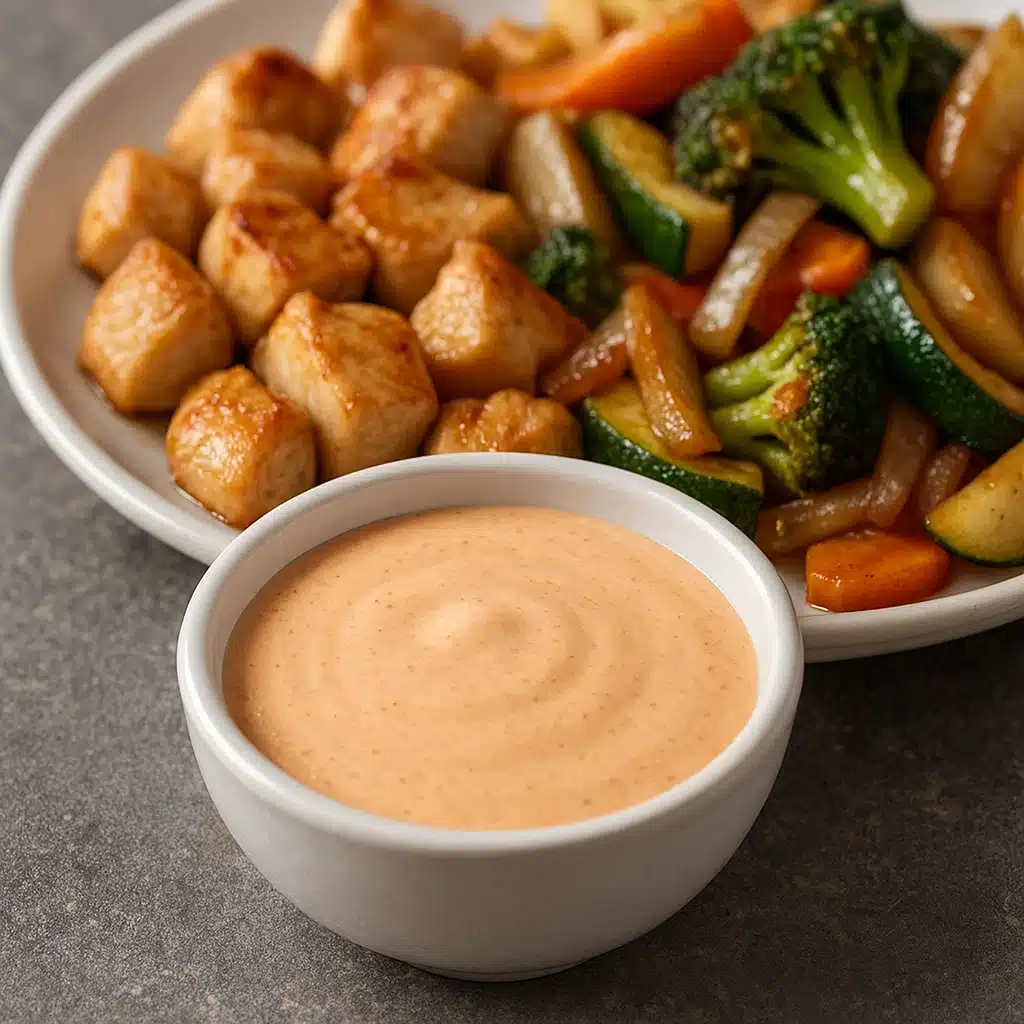
How to Make Authentic Yum Yum Sauce at Home
No hibachi chicken recipe is complete without a side of yum yum sauce—the creamy, tangy, slightly sweet dip you’ll find at nearly every Japanese steakhouse in the U.S.
Here’s how to make it at home with ingredients you probably already have:
Yum Yum Sauce Ingredients:
- 1 cup mayonnaise
- 1 tablespoon ketchup
- 1 tablespoon rice vinegar
- ¾ teaspoon paprika
- ⅛ teaspoon garlic powder
- Salt and pepper to taste
Just mix everything together in a bowl and whisk until smooth. For the best results, refrigerate for at least an hour before serving. This lets the flavors meld together and become even more irresistible.
Pro tip: Want a spicy twist? Add a few drops of hot sauce or a pinch of cayenne.
Yum yum sauce complements chicken, shrimp, and vegetables perfectly, adding a creamy, flavorful finish to every bite. You can even drizzle it over hibachi fried rice for extra flavor.
Is Marinating Necessary for Hibachi Chicken?
Here’s the good news: You don’t need to marinate chicken for hours to get that authentic hibachi flavor. In fact, most hibachi chefs cook the chicken fresh and season it directly in the pan with:
- Low-sodium soy sauce
- Minced garlic
- Butter
- Salt and pepper
That said, if you want to prep ahead, you can let the chicken sit for 20–30 minutes in a simple mix of soy sauce, a dash of sesame oil, and garlic. It helps tenderize and adds a deeper umami base.
But again, traditional hibachi relies more on quick high-heat cooking than long marinades.
How Sauces Elevate Hibachi Flavor: Soy, Teriyaki, and Hoisin
Besides the main dipping sauce, flavor in hibachi cooking often comes from a combination of quick-poured sauces right in the hot pan. Each one adds its own magic:
| Sauce | Flavor Profile | When to Use |
|---|---|---|
| Soy Sauce | Salty, umami-rich | During cooking—adds deep base flavor |
| Teriyaki Sauce | Sweet, tangy, slightly thick | Optional drizzle over finished dish |
| Hoisin Sauce | Rich, sweet-savory, bold | For added depth and an Asian-style kick |
| Oyster Sauce | Briny, salty-sweet, deep umami | Optional—pairs great with mushrooms |
You can stick to the basics or experiment by adding a spoonful of hoisin sauce or a splash of teriyaki for variety. Want to go bold? Try a bit of toasted sesame oil or a touch of rice vinegar to cut through the richness.
Step-by-Step: How to Make Hibachi Chicken at Home
Craving that sizzling, buttery restaurant-style flavor without leaving your kitchen? Making hibachi chicken at home is much easier than it looks. With the right timing, heat, and ingredients, you’ll have a meal that tastes straight off the teppanyaki grill.
Here’s your full walkthrough—from prepping the chicken to stir-frying the vegetables to plating with rice and that irresistible sauce.
Cooking the Chicken Like a Hibachi Chef
To get that signature hibachi flavor, it’s all about high heat and fast movement. Here’s how to do it:
Instructions:
- Heat the oils: In a large skillet or wok, heat 1 teaspoon sesame oil and 1 teaspoon olive or vegetable oil over medium-high heat.
- Cook the chicken: Add 3 boneless skinless chicken breasts, cut into 1-inch cubes. Season lightly with salt and pepper.
- Sauté for flavor: After about one minute, stir in 1 tablespoon butter, 1 tablespoon low-sodium soy sauce, and 3 cloves of minced garlic.
- Finish cooking: Sauté everything until the chicken is golden brown and cooked through. This takes about 4–6 minutes. Once done, remove the chicken from the pan and cover with foil to keep warm.
Quick Tip: Don’t overcrowd the pan—cook in batches if needed to keep that perfect sear.
Stir-Frying Vegetables with Authentic Hibachi Flair
With the chicken out of the way, it’s time for the colorful, crispy vegetables that round out any good chicken hibachi recipe.
Veggies You’ll Need:
- 2 teaspoons sesame oil (1 left for veggies)
- 2 teaspoons vegetable or olive oil (1 left for veggies)
- 1 carrot, thinly sliced
- 2 zucchini, chopped
- 1 medium onion, chopped
- 1 (8 oz) package fresh cremini mushrooms, halved
Steps:
- Add remaining oils: In the same pan, pour in the leftover 1 teaspoon sesame oil and 1 teaspoon vegetable or olive oil.
- Sauté hard veggies first: Add carrots and onions and cook on high heat for 1–2 minutes.
- Add soft veggies next: Toss in mushrooms and zucchini.
- Season and finish: Stir in 1 tablespoon butter, 1 tablespoon soy sauce, and season with salt and pepper. Sauté until everything is tender-crisp but not mushy.
Bringing It All Together: Plating and Serving
Once the veggies are tender and the chicken is hot, combine them in the same pan for one final toss to let flavors marry.
Serve over a warm bed of:
- Steamed white rice for a clean, traditional base
- Or fried rice for that savory, garlic-kissed richness
And don’t forget the yum yum sauce on the side for dipping. It elevates every bite with a creamy, tangy contrast to the savory meat and veggies.
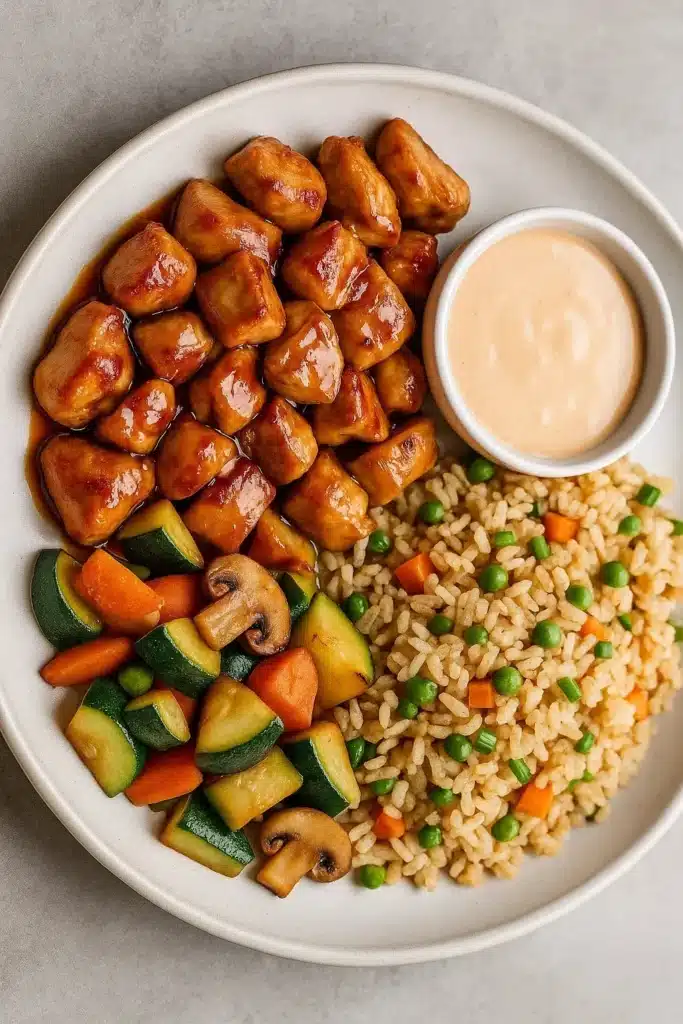
Tips from Chefs: Secrets to Perfect Chicken Hibachi Every Time
Making hibachi chicken at home is all about technique. You’ve got the ingredients down—now let’s talk about how to take it from good to restaurant-level greatness. Here are some time-tested chef tips to make your chicken hibachi taste just like it came off a teppanyaki grill.
Right Temperature and Cookware for Hibachi Cooking
The secret weapon of any hibachi chef? High heat and the right pan. Teppanyaki grills run blazing hot, so replicating that at home requires a bit of planning.
Here’s how to get it right:
- Use a large, heavy skillet or wok – Cast iron or carbon steel holds and distributes heat well.
- Preheat your pan until it’s almost smoking before adding oil.
- Avoid nonstick pans for hibachi—it limits browning and won’t give you that flavorful sear.
That hot, even cooking surface is what helps caramelize the butter, garlic, and soy sauce into a glossy glaze over the chicken and veggies.
The Role of Butter in Hibachi Cooking: What Type Do Chefs Prefer?
If you’ve ever wondered what kind of butter do they use at hibachi, the answer is surprisingly simple: unsalted butter—and lots of it.
Chefs use butter to:
- Enhance richness and mouthfeel of both chicken and vegetables
- Balance salty flavors from soy sauce
- Create that signature sizzle and aroma that hits your nose the moment your plate arrives
Some restaurants mix butter with garlic paste or sesame oil for extra depth, but at home, plain unsalted butter gets the job done perfectly.
Want a twist? Add a touch of garlic-infused or herb-flavored butter to elevate your dish with a personalized twist.
Tricks to Get the Texture and Taste Just Right
Professional hibachi chefs don’t just rely on ingredients—they use rhythm, control, and smart timing. Here’s how to replicate that:
- Cut meat and veggies evenly – Uniform pieces = even cooking and no dry bits.
- Don’t stir too much – Let ingredients sit in the hot pan a few seconds to build browning.
- Layer your seasoning – Add soy sauce and garlic partway through cooking, not just at the end.
- Finish with a toss of butter and soy – This creates a light glaze that clings to everything.
Remember, the goal isn’t soggy stir-fry—it’s crisp-tender veggies and juicy, golden chicken.
Hibachi Chicken Nutrition Information: Is It Healthy?
While hibachi chicken is famous for its bold flavor and sizzling presentation, many home cooks wonder whether it can also be a nutritious choice. The short answer? Yes—with a few smart tweaks. This part breaks down the calorie count, ingredients, and healthy swaps to help you enjoy your favorite chicken hibachi recipe without the guilt.
Hibachi Chicken Calories and Macros Breakdown
The exact calorie count of hibachi chicken depends on portion size, oils, sauces, and whether you’re pairing it with fried rice or white rice. But here’s a general snapshot:
| Component | Estimated Calories per Serving |
|---|---|
| Chicken (3 breasts) | ~330–400 |
| Sesame & olive oil (2 tsp) | ~80 |
| Butter (2 tbsp) | ~200 |
| Soy sauce (3 tbsp) | ~30 |
| Veggies (zucchini, onions, carrots, mushrooms) | ~100 |
| White rice (1 cup cooked) | ~200 |
| Yum Yum Sauce (2 tbsp) | ~150 |
Total (approx.): 700–900 calories per serving, depending on portion sizes and sides.
Despite the richness, hibachi chicken is high in protein and can be quite balanced when made at home using healthy oils and moderate sauce portions.
Adjusting for a Dairy-Free or Low-Sodium Diet
One of the best things about homemade chicken hibachi is how easy it is to modify:
- Dairy-Free Version: Swap out butter for toasted sesame oil, olive oil, or a plant-based butter alternative. You’ll still get the glossy finish and rich flavor without any dairy.
- Low-Sodium Adjustments: Use low-sodium soy sauce and skip any additional table salt. Garlic, sesame oil, and mushrooms naturally boost the umami, ensuring the dish stays rich in flavor even with less salt.
- Lighter Sauces: Skip the yum yum sauce or replace with a simple garlic-soy drizzle to reduce added calories and fats.
Using Olive Oil vs. Vegetable Oil
Both oils are common in hibachi recipes, but they come with slight nutritional differences:
| Oil Type | Smoke Point | Flavor Profile | Health Notes |
|---|---|---|---|
| Olive Oil | ~375°F | Slightly fruity, light | Rich in healthy fats, great for heart health |
| Vegetable Oil | ~400°F | Neutral | Affordable and versatile but may be more processed |
For high-heat cooking like hibachi chicken, either oil works—but olive oil provides added antioxidants and a smoother flavor when paired with sesame oil and garlic.
Hibachi Chicken vs Teriyaki Chicken: What’s the Real Difference?
It’s a question almost every Japanese cuisine fan has asked: Is hibachi chicken the same as teriyaki chicken? While they may look similar at first glance, the flavor profiles, cooking methods, and even the sauces set them miles apart. Understanding these differences can help you choose the right dish for your mood—or even combine elements of both in your next homemade meal.
Key Ingredients and Cooking Styles Compared
Let’s start with the basics: what actually goes into each dish?
| Feature | Hibachi Chicken | Teriyaki Chicken |
|---|---|---|
| Primary Protein | Chicken breast or thigh, cubed | Chicken thigh or breast, typically left whole or sliced |
| Cooking Style | Grilled or pan-seared on high heat without marinating | Usually grilled or pan-cooked with a pre-made glaze |
| Sauce Base | Soy sauce, garlic, butter, sesame oil (cooked fresh) | Teriyaki glaze (soy sauce, mirin, sugar, sake) |
| Vegetables | Mushrooms, onions, carrots, zucchini (sautéed with chicken) | Rarely served with mixed veggies |
| Final Flavor | Buttery, smoky, savory, light umami | Sweet, sticky, caramelized glaze |
As you can see, hibachi chicken is built around quick, high-heat grilling and minimal prep, while teriyaki chicken is all about a rich, sweet marinade or glaze.
Taste and Texture Differences Explained
Hibachi chicken is all about the savory. Thanks to the use of garlic, butter, and soy sauce, you get a deeply satisfying umami bite that isn’t overly salty or sweet. It’s usually paired with crisp-tender stir-fried vegetables and a lighter finish.
Teriyaki chicken, on the other hand, leans heavily on a sweet-savory balance. The thick sauce caramelizes as it cooks, creating a shiny coating that clings to the meat. It’s softer, juicier, and almost dessert-like compared to the subtle smokiness of hibachi.
Want a fun twist? Try mixing the two: cook your chicken hibachi-style, then finish with a light drizzle of teriyaki glaze.
When to Choose One Over the Other
- Choose hibachi chicken when you’re craving a lighter, more balanced meal with veggies and rice. It’s also great for meal prep or quick weeknight dinners.
- Go for teriyaki chicken when you want bold sweetness and that signature glossy finish—perfect over steamed rice with broccoli or in a rice bowl.
Whether you prefer one or love both, knowing the difference helps you choose—or customize—the dish based on your taste or dietary goals.
How to Customize Hibachi Chicken to Suit Any Diet
One of the best things about hibachi chicken is how incredibly adaptable it is. Whether you’re eating low-carb, dairy-free, gluten-free, or even plant-based, this dish is flexible enough to meet your needs without sacrificing flavor.
Here’s how to customize your chicken hibachi recipe to fit your personal diet, taste, or health goals.
Low-Carb, Keto, Gluten-Free, or Dairy-Free Swaps
With a few quick substitutions, you can make hibachi chicken work for nearly any dietary plan:
- Low-Carb / Keto:
Skip the rice and serve your chicken and veggies over cauliflower rice or zucchini noodles. Swap out soy sauce for tamari or coconut aminos to reduce sodium and carbs. - Dairy-Free:
Instead of butter, use olive oil, avocado oil, or toasted sesame oil for richness. The result is still glossy and flavorful without any dairy. - Gluten-Free:
Use gluten-free soy sauce or tamari. Also, double-check any packaged sauces like hoisin or teriyaki—they often contain wheat. - No Added Sugar:
Stick to savory seasonings like garlic, sesame oil, and soy sauce. Avoid sugary glazes or commercial teriyaki sauces.
These swaps are easy and require no extra cooking steps—just ingredient awareness.
Using Shrimp, Tofu, or Steak Instead of Chicken
Want to change up the protein? No problem. Hibachi-style cooking works for all kinds of proteins:
- Shrimp – Quick-cooking and delicious when seared with garlic and soy
- Steak – Slice it thin and cook just until browned; pairs well with hoisin or garlic butter
- Tofu – Use firm tofu, pressed and cubed; sauté until golden before adding sauce
You can even try a combo of proteins, like many hibachi restaurants do. Chicken and shrimp together? That’s a fan favorite for a reason.
Swapping Sauces: Spicy Hibachi, Hoisin-Glazed, or Garlic Butter
Tired of the same old soy-based flavor? Get creative with your sauce game:
- Spicy Hibachi Sauce: Add hot sauce or sriracha to your base sauce for heat
- Hoisin-Glazed: Mix soy sauce with hoisin and a touch of brown sugar for deeper flavor
- Garlic Butter: Melt butter with garlic and a splash of rice vinegar—simple but bold
You can also experiment with yum yum sauce variations—think smoky paprika, spicy mayo, or dairy-free alternatives.
By mixing and matching sauces, you’ll never get bored of this staple dinner.
Easy Storage, Reheating & Meal Prep for Hibachi Chicken
One of the reasons hibachi chicken is a household favorite? It stores and reheats beautifully—making it perfect for leftovers, meal prep, or quick weeknight dinners. Whether you’re cooking a big batch or just planning ahead, here’s how to keep your chicken hibachi tasting fresh every time.

How to Store Hibachi Chicken and Veggies
Once cooled, place your leftover chicken, veggies, and rice in an airtight container. Store them together or separately depending on how you plan to reheat.
| Item | Storage Method | Shelf Life (Fridge) |
|---|---|---|
| Cooked Chicken | Airtight container | 3–4 days |
| Sautéed Veggies | Airtight container | 3 days |
| Fried or White Rice | Sealed, dry container | 4–5 days |
| Yum Yum Sauce | Refrigerated, covered | Up to 1 week |
Tip: Avoid leaving food uncovered or warm before refrigerating, as moisture can affect texture and promote spoilage.
Reheating Tips to Retain Flavor and Texture
Reheating hibachi chicken is simple, but a few tips can make the difference between dry and juicy.
- Skillet Reheat (Best Method):
Heat a pan over medium heat with a touch of oil or butter. Add the chicken and veggies, cover, and reheat for 3–4 minutes, stirring occasionally. - Microwave Reheat:
Place food in a microwave-safe container. Add a splash of water or soy sauce to keep moisture, cover loosely, and heat in 45-second bursts. - Oven Reheat:
If reheating larger portions, cover with foil and bake at 350°F for 10–15 minutes.
Avoid overcooking during reheating—hibachi chicken is best when it stays moist and flavorful, not rubbery or dry.
Make-Ahead Meal Ideas for Busy Weeknights
Hibachi chicken makes a fantastic meal prep option. Cook a large batch on Sunday and mix and match throughout the week:
- Lunch Bowls: Combine chicken, veggies, and rice in portioned containers. Add a small cup of yum yum sauce on the side.
- Hibachi Wraps: Wrap your leftovers in a tortilla with shredded lettuce and spicy mayo.
- Protein-Packed Salads: Serve cold hibachi chicken over a bed of greens with a sesame vinaigrette.
You can also freeze cooked chicken and rice (minus the veggies and sauce) in freezer bags for up to 2 months.
Conclusion: Why Hibachi Chicken Deserves a Spot in Your Weekly Dinner Rotation
If you’re looking for a meal that’s quick, flavorful, and endlessly customizable, hibachi chicken is it. With simple ingredients like soy sauce, garlic, and butter, you can recreate restaurant-style taste right in your kitchen—no teppanyaki grill required.
From juicy, high-heat seared chicken to crisp sautéed vegetables and creamy yum yum sauce, every bite delivers bold flavor and comfort. It’s also easy to adjust for dietary needs—low-carb, gluten-free, dairy-free, or even vegan alternatives make this dish a versatile staple for any home cook.
Whether you’re cooking for one or feeding a family, chicken hibachi brings excitement to the dinner table with very little effort. So next time you’re in a dinner rut, reach for your skillet, grab those veggies, and let the hibachi sizzle begin.
Hibachi Chicken FAQs
Hibachi chicken is a Japanese-style grilled chicken dish often served at teppanyaki restaurants. It’s typically made by cooking diced chicken over high heat on a flat-top grill with soy sauce, garlic, butter, and sesame oil. Served with stir-fried vegetables and rice, it’s known for its bold umami flavor and tender texture.
While both dishes use similar ingredients, the difference lies in preparation and flavor:
– Hibachi chicken is seared quickly with soy sauce, garlic, and butter for a savory, smoky finish.
– Teriyaki chicken is marinated in and glazed with a sweet, thick sauce made from soy sauce, sugar, and mirin or sake.
Hibachi has a lighter, more savory taste, while teriyaki is sticky-sweet.
The main seasonings used in hibachi cooking include:
– Low-sodium soy sauce
– Minced garlic
– Sesame oil
– Salt and pepper
– Unsalted butter
Some chefs may also add a splash of teriyaki, hoisin, or oyster sauce depending on the dish.
On a restaurant menu, hibachi typically refers to food prepared on a flat-top grill (technically a teppanyaki). Dishes labeled “hibachi” are grilled with high heat and often include a combination of meat, vegetables, rice, and dipping sauces like yum yum sauce.
Unlike many other dishes, you don’t need to marinate chicken for hibachi. The flavor comes from seasoning it during the cooking process with garlic, soy sauce, and butter. However, a short 20-minute soak in a basic hibachi chicken marinade (soy sauce, sesame oil, garlic) can deepen the flavor if you prefer.
Hibachi chefs typically use unsalted butter, often melted directly into the pan with garlic and soy sauce. Some restaurants may enhance it with garlic paste, herbs, or even a touch of toasted sesame oil to boost flavor.

